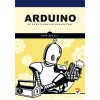- Out-of-Stock



John Boxall
About the book
Arduino is a platform thanks to which the world of electronics has gained many new, interesting solutions and possibilities. The simplicity of use, great documentation and a specially designed environment for software development have made this project won thousands of supporters. Such success has translated into the number of available accessories and instructions, thanks to which you can build any electronic system.
In this book, 65 interesting projects with varying degrees of difficulty were collected. Thanks to them, you will quickly master the principles of using the platform and build devices that will be useful in everyday use. The first projects will allow you to get acquainted with Arduino - one of them is for example creating a wave of flashing LEDs. Performing more will allow you to achieve a higher degree of initiation: car traffic control, battery testing, electronic dice, temperature measurement or use of the GPS system are just some of them. This book is a must-read for everyone who wants to learn the secrets of the Arduino platform and build amazing electronic circuits.
Build your own:
Table of Contents
Thanks (17)
1. Introduction (19)
2. First look at the Arduino plate and IDE environment (37)
3. First steps (51)
4. Circuit components (73)
5. Working with functions (113)
6. Numbers, variables and arithmetic operations (131)
7. Liquid crystal displays (171)
8. Extending the capabilities of the Arduino platform (187)
9. Numeric keyboards (217)
10. Reading user input data via touch screens (225)
11. The Arduino product family (237)
12. Engines and movement (255)
13. Use of the GPS system on the Arduino platform (289)
14. Wireless data transmission (303)
15. Remote control using infrared (319)
16. Reading RFID labels (329)
17. Data buses (343)
18. Real-time clocks (361)
19. Internet (379)
20. Communication in a mobile telephone network (393)
Index (411)
ART016002E29-YLY-R LCD display 2x16, 80x36mm, LED backlight (yellow-green), extended temperature range, RoHS
No product available!
Camera with a resolution of 0.3 MPx with a USB interface. Equipped with a CMOS OV7725 sensor with a wide-angle lens with a viewing angle of 120°. ArduCAM U6066
No product available!
No product available!
No product available!
Module with transparent OLED display. It has a display area of 128 x 64 pixels, of which 128 x 56 pixels are completely transparent. I2C or SPI communication. SparkFun LCD-15173
No product available!
No product available!
Multicase NS301 from the Cargo series is a solid organizer made of high quality plastic, with 6 transparent drawers
No product available!
No product available!
Adafruit 1697 - Bluefruit LE - Bluetooth Low Energy (BLE 4.0) - nRF8001 Breakout - v1.0
No product available!
No product available!
No product available!
No product available!
ROSA3D filament made of high-quality PLA granules. 0.8 kg of filament with a diameter of 1.75 mm is wound on the spool. ROSA3D PLA Starter White Pearl Satin
No product available!
No product available!
No product available!
Series 2 improves on the power output and data protocol. Series 2 modules allow you to create complex mesh networks based on the XBee ZB ZigBee mesh firmware. WRL-11217
No product available!

John Boxall
